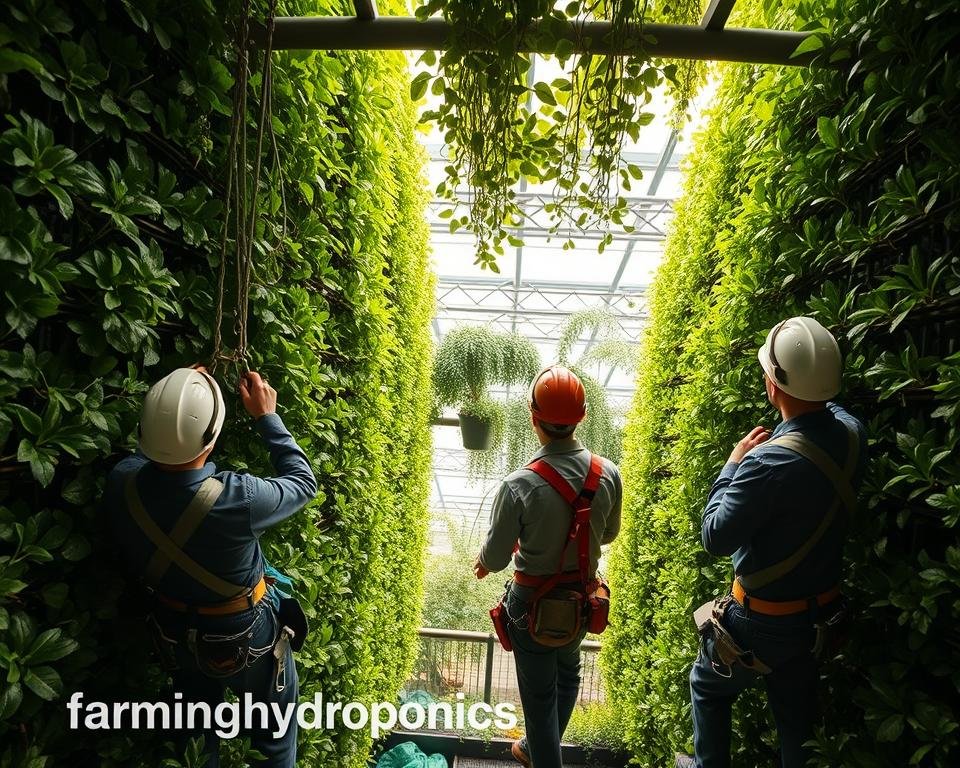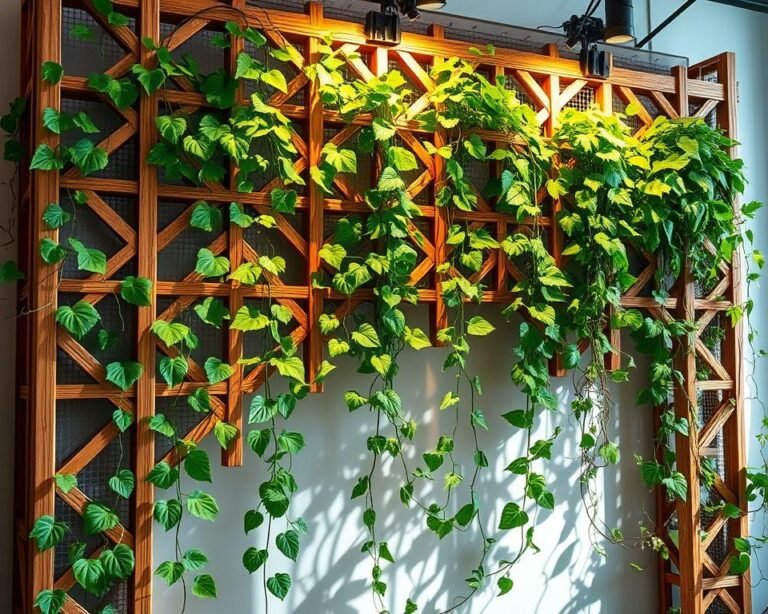Safety Practices for Vertical Gardens
As an urban gardener, I discovered that vertical-gardens can transform a cramped balcony into a lush retreat, but only when solid safety practices are in place. My space-saving project quickly taught me that plant health and user safety go hand in hand.
Vertical gardening is revolutionizing city farming by compressing cultivation into stacked layers, saving up to 80 % of the area required by traditional gardens. These green walls add beauty and boost air quality, yet they also demand careful attention to structural integrity, sanitation, and irrigation design.
Adopting the right safety practices—secure anchoring, clean watering systems, and regular disease checks-keeps your vertical garden thriving and hazard-free. From choosing sturdy frames to preventing mold and pests, each step protects both your plants and your living space, ensuring a productive, worry-free urban oasis.
Key Takeaways
- Vertical-gardens can dramatically reduce space requirements for growing plants
- Proper maintenance is critical for garden health and safety
- Hygiene and regular monitoring prevent potential plant diseases
- Urban gardeners can maximize limited spaces effectively
- Strategic planning ensures a thriving vertical garden ecosystem
Understanding Vertical Garden Systems and Safety Fundamentals
Vertical-gardens are a new way to grow food and decorate spaces. They need careful planning to be safe. It’s important to follow safety rules to protect the garden and those who take care of it.
When setting up vertical-gardens, knowing about hazards is key. Different materials have their own challenges:
- Wood structures need regular checks for moisture and rot
- Metal frameworks must be protected from rust
- Plastic systems should be checked for UV resistance
Vertical Garden Structure Types
There are many types of vertical garden structures, each with its own safety needs. Wall-mounted systems, free-standing units, and modular designs all need special safety checks. It’s important to look at the structure’s strength, how it holds weight, and how it handles the weather.
Basic Safety Components
Important safety parts include:
- Strong mounting systems
- Good drainage systems
- Enough support for the structure
- Materials that can stand up to the weather
Risk Assessment Foundations
Doing a thorough risk assessment is essential. It means looking at all possible dangers. By finding and fixing risks early, we can avoid accidents. Regular checks, upkeep plans, and knowing how the garden interacts with the environment help keep it safe.
Safety is not an accident, but a deliberate and continuous process of awareness and prevention.
Essential Safety Practices for Vertical Garden Management
Managing a vertical-garden needs careful safety steps. Using personal protective gear and being ready for emergencies can lower risks. Knowing how to manage a vertical garden keeps plants and workers safe.
Here are key safety steps for vertical-gardens:
- Wear the right personal protective equipment, like:
- Protective gloves
- Safety glasses
- Dust masks
- Protective footwear
- Do regular workplace checks to spot dangers
- Make a detailed plan for emergencies
- Keep work areas clean and tidy
Workplace checks are key to avoiding accidents. Make a checklist for things like structure, water systems, and plant diseases. Checking often can stop 90% of safety problems before they start.
Being ready for emergencies means having clear plans for different situations. This includes knowing how to deal with broken equipment, pests, and unexpected problems. Your team should know how to act fast.
Safety is not an accident – it’s a deliberate and continuous process of awareness and prevention.
By following these safety steps, you’ll make a safe place for your team and your garden. Good safety management is the key to a successful vertical garden.
Environmental Control and Monitoring Systems
Vertical-gardens need careful environmental control to keep plants healthy and ensure safety. With 90% of businesses seeing environmental monitoring as crucial, strong control systems are essential for success.

Modern vertical-garden management uses advanced monitoring tech for real-time insights. The use of IoT devices has boosted monitoring by 50%. This allows for more precise data and better risk management.
Temperature and Humidity Management
Keeping the right temperature and humidity is key for vertical-garden health. Rules often set specific ranges to avoid plant stress and damage:
- California workplace standards suggest temperatures between 68-78°F
- Keeping humidity levels steady stops plants from drying out
- Real-time sensors track changes in the environment
Lighting Safety Requirements
Right lighting is vital for vertical-garden success. Safety training should cover:
- How to install grow lights correctly
- Keeping electrical safety standards
- Knowing how long plants need light
Air Circulation Standards
Good air circulation stops moisture buildup and lowers disease risk. Incident reporting systems help track ventilation issues. Wireless sensors offer reliable monitoring over long distances.
Remember: Continuous environmental monitoring is key to maintaining a safe and productive vertical garden ecosystem.
With thorough safety training and strong incident reporting, you can build a thriving vertical garden. This environment minimizes risks and boosts plant health.
Maintenance Protocols and Personal Protection

Creating a strong safety culture in vertical gardening is key. It needs good maintenance and personal protection plans. Your garden management should focus on keeping plants healthy and workers safe.
Personal protective equipment (PPE) is very important in vertical garden care. The National Institute for Occupational Safety and Health (NIOSH) says PPE is the last defense in safety plans.
- Wear safety goggles that meet ANSI Z87.1 standards
- Use chemical-resistant gloves when applying fertilizers
- Wear respiratory protection when dealing with dusty materials
- Choose slip-resistant shoes to avoid accidents
Following safety rules is a must in garden maintenance. By getting experienced staff involved in making policies, safety can improve by 20%.
| Safety Metric | Potential Improvement |
|---|---|
| Safety Training | 50% less workplace injuries |
| Safety Audits | 70% better safety compliance |
| Near-Miss Reporting | 60% fewer actual accidents |
Regular checks and hazard assessments are vital for a safe vertical garden. With detailed safety plans, you can keep your plants and workers safe. This ensures your garden works well.
Plant Health and Disease Prevention Strategies
Vertical gardens need careful attention to keep plants healthy. Knowing your garden’s ecosystem helps stop diseases and keeps plants strong.

Common Plant Diseases in Vertical Gardens
Spotting plant diseases early is key for good pest control. Several major problems can harm your garden:
- Fungal infections
- Bacterial blights
- Viral transmission
- Root rot
Preventive Measures and Treatment Protocols
Use smart maintenance to protect your garden. Good prevention needs a few steps:
- Regularly check plant leaves
- Keep air moving
- Control humidity
- Choose organic pest control
| Disease Type | Prevention Strategy | Treatment Method |
|---|---|---|
| Fungal Infections | Reduce moisture | Targeted fungicide application |
| Bacterial Blight | Sterilize gardening tools | Prune infected areas |
| Root Rot | Improve drainage | Replace soil, reduce watering |
Safe Handling of Plant Materials
When dealing with sick plants, wear protective gear. Use careful disposal techniques. Isolate sick plants to stop disease spread. Most garden insects are good, with only a small percent being pests.
Remember: Prevention is always more effective than cure in vertical garden management.
Structural Integrity and Equipment Safety
When you set up your vertical garden, making sure it’s sturdy is key. You need to watch out for how much weight it can hold and where stress might build up. Checking your garden regularly can spot up to 90% of problems before they get worse.
Keeping your garden in good shape means checking how it handles weight and support. Things like moisture and changes in temperature can make your garden weaken by 2-5% each year. By checking your garden often, you can save up to 30% on repairs and keep it stable for longer.
It’s also important to keep an eye on your garden’s equipment. This includes things like how it’s mounted, its water system, and lights. Using special tests can find problems inside with 95% accuracy. Using strong fasteners can make your garden hold more weight, keeping it safe.
By focusing on making your garden strong, you create a safe place for it to grow. Regular checks and keeping records can help you follow safety rules over 90% of the time. This ensures your garden is not only safe but also healthy and productive.







